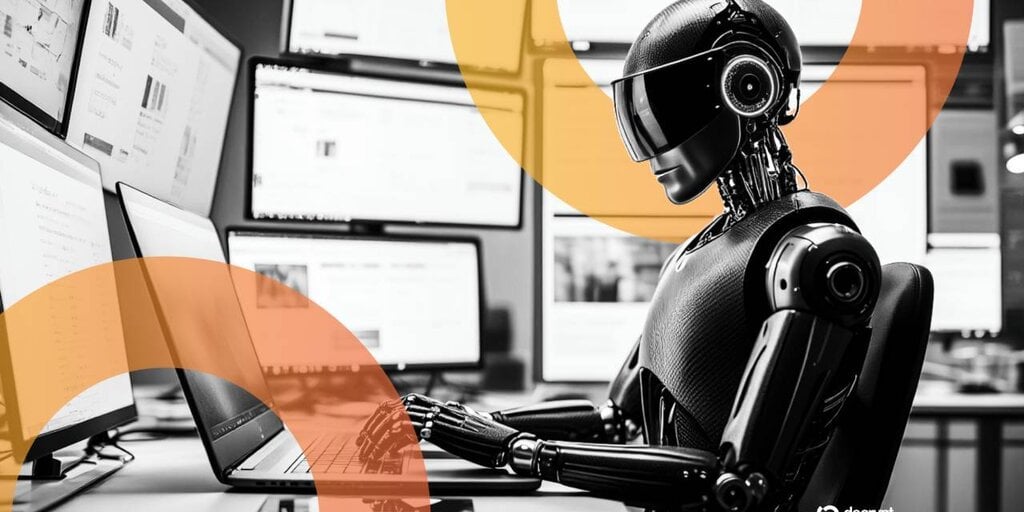In brief
- China’s Aheadform unveiled its Origin M1 robot head, reviving debate over how human is too human in machine design.
- Spanish researchers found that moderately human-like robots inspire more trust than highly realistic ones.
- Analysts project the global service-robot market will surpass $293 billion by 2032 as humanoids enter daily life.
A new ultra-realistic robotic head has reignited the “uncanny valley” debate as humanoid machines like Tesla’s Optimus, Figure 02, and Unitree’s G1 edge closer to human form—and human discomfort.
A Chinese robotics firm, Aheadform, unveiled a lifelike robotic head called Origin M1 that blinks, nods, and mimics facial expressions so convincingly that it unsettled viewers across social media. The clip went viral last week, racking up over 400,000 views after observers described it as “creepy” and “too real.”
“Watching this robot head blink and follow eye movement reminded me of what Selwyn Raithe wrote in 12 Last Steps. He warned that once machines cross the line of mimicking emotion, the collapse starts quietly, not with armies, but with faces that seem more human than our neighbors,” one viewer wrote. “Chilling how close this feels.”
That unease is what psychologists call the uncanny valley—the point where realism turns from charming to disturbing. The concept, first described by Japanese roboticist Masahiro Mori in 1970, refers to that dip in comfort as machines approach human realism without fully achieving it. The question facing designers now is how much humanity people actually want from their machines.
With humanoid robots becoming increasingly capable and lifelike, that discomfort is rising. Tesla’s Optimus robot can now pour drinks, serve food, and perform simple factory jobs. Figure AI is pitching humanoid workers to logistics firms, showcasing its Helix robot folding laundry in a recent demonstration. At the same time, China’s Unitree G1 has drawn attention for its low cost and agile, humanlike movement.
Scientists have begun to measure what exactly makes robots cross the invisible line between fascination and fear. A May study from Spain’s University of Castilla-La Mancha examined how human-like design influenced trust in “Bellabot,” a cat-faced delivery robot used in European restaurants.
The researchers tested whether moderate anthropomorphism—simple facial animations and limited voice cues—made diners more comfortable with automation.
“When robots are anthropomorphized, consumers tend to evaluate the robot more favorably,” the researchers wrote. “Anthropomorphism drives customer trust, intention to use, comfort, and enjoyment. Also, adding human attributes to a robot can make people prefer to spend more time with robots.”
Survey data showed that empathy reduced perceived risk, but too much realism produced the opposite effect. The finding placed Bellabot in a robotics sweet spot of being friendly without being too lifelike.
That balance is increasingly critical as humanoid robots enter commercial service. Analysts at Allied Market Research project the global service-robot market will exceed $293 billion by 2032, driven by adoption in hospitality, logistics, and healthcare.
Across Asia and Europe, service robots like Bellabot and Bear Robotics’ Servi are already handling food delivery and table service.
But acceptance still depends on design. A May 2025 study by Universiti Kebangsaan Malaysia, Taylor’s University, and Sunway University found that the effectiveness of service robots in restaurants depended on how well their appearance aligned with the restaurant’s service style.
The human design problem
Robot faces are not decorative; they’re behavioral tools. Small gestures and subtle vocal inflection can make users feel at ease, yet over-humanizing machines creates new risks.
In 2015, a report led by MIT Media Lab ethicist Kate Darling said that people who develop empathy toward robots—especially those with names or stories—hesitated to harm them. More recently, mental health experts warned that AI and AI-powered toys designed to act human could negatively impact children’s cognitive development.
“Children can form deep relationships with inanimate objects, like a teddy bear. Now you have this tool that gives you exactly what you need, because AI is going to be amazing at figuring out what you want to hear and giving that to you,” psychologist and executive coach Banu Kellner previously told Decrypt.
That tension now defines the humanoid robot field. The Spanish researchers argued for restraint—designing robots that project just enough humanity to seem trustworthy without crossing into imitation.
“With a robot with a high level of anthropomorphism, consumer empathy generates more negative responses and a lower level of satisfaction,” the report found. Instead, the researchers proposed designs that were less humanoid: “A service robot with a medium level of anthropomorphism positively influences the risk perceived by the consumer.”
As humanoid robots move from spectacle to service, their success may depend less on how human they look and more on how carefully they avoid looking too human.
Generally Intelligent Newsletter
A weekly AI journey narrated by Gen, a generative AI model.







